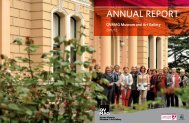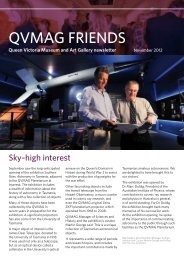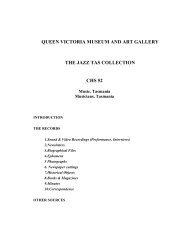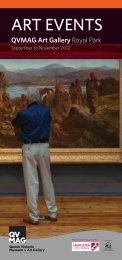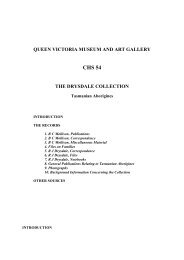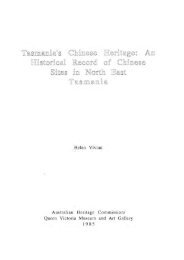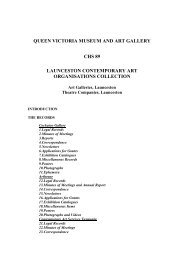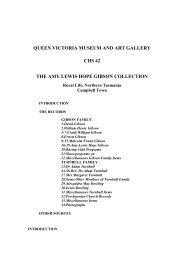Art - Queen Victoria Museum and Art Gallery
Art - Queen Victoria Museum and Art Gallery
Art - Queen Victoria Museum and Art Gallery
You also want an ePaper? Increase the reach of your titles
YUMPU automatically turns print PDFs into web optimized ePapers that Google loves.
• LOUISE JAMES <strong>and</strong> ANN TEESDALE continued researching<br />
Tasmania’s sporting heritage while preparing the exhibition<br />
Replay: Sporting life in Tasmania, which will open in 2005.<br />
• BRIAN SMITH continued work on the Checklist of Tasmanian<br />
Mollusca <strong>and</strong> on selected species of charopid l<strong>and</strong> snails.<br />
He contributed to work on Cretaceous opalized fossil snails<br />
as a joint project with staff of the South Australian<br />
<strong>Museum</strong>.<br />
• BOB MESIBOV continued investigations in millipede<br />
taxonomy <strong>and</strong> biogeography.<br />
• LISA BOUTIN continued her study of New Caledonian species<br />
of the spider family Clubionidae, with many new species<br />
coming to light. Comparative material from Fiji <strong>and</strong> other<br />
parts of the Pacific was obtained. She continued work with<br />
Dr Schlinger on acrocerid flies that parasitise spiders.<br />
Several new species <strong>and</strong> association records have come to<br />
light from Tasmania <strong>and</strong> elsewhere.<br />
• CRAIG REID continued his work on ant identification from a<br />
diverse collection of Tasmanian material.<br />
• TAMMY GORDON began a study of mammalian hair<br />
identification.<br />
EMERGENCY DOCUMENTATION<br />
An innovative program at the <strong>Museum</strong> ensures that the rapidly<br />
changing face of both urban <strong>and</strong> country areas in Tasmania is<br />
recorded for the future. Many of the changes are occurring<br />
because of altering economic <strong>and</strong> social conditions in<br />
industries <strong>and</strong> community facilities which are no longer viable<br />
or relevant. Frequently the <strong>Museum</strong> is made aware of the<br />
situation at short notice <strong>and</strong> a quick response is needed.<br />
The documentation program has recorded a number of these<br />
transitions in recent years.<br />
The program may involve photographic documentation of sites,<br />
work practices <strong>and</strong> people, the acquisition of memorabilia,<br />
records <strong>and</strong> objects, archaeological site recording <strong>and</strong> oral<br />
history interviews.<br />
During the year the following documentation projects were<br />
undertaken:<br />
• Exeter Masonic Lodge<br />
• Ulverstone Playground<br />
• Devonport Athletic Carnival<br />
• Simplot Factory, Scottsdale<br />
• North Eastern Advertiser, Scottsdale.<br />
• IAN NORTON continued his ecological research on the elapid<br />
snakes at Northdown, near Wesley Vale <strong>and</strong> on selected<br />
Bass Strait Isl<strong>and</strong>s. He is also cooperating with research<br />
being carried out in Pathology at Launceston General<br />
Hospital <strong>and</strong> in Deakin University, Geelong on Rickettsia<br />
disease—a parasite carried by ticks which infest snakes<br />
<strong>and</strong> other reptiles.<br />
Launceston General Hospital’s Radiology Department manager Garth Faulkner <strong>and</strong> <strong>Museum</strong> researcher Craig Reid<br />
taking X-rays of one of the <strong>Museum</strong>’s thylacine specimens. Watching on are radiographer Graham Kentworthy <strong>and</strong><br />
<strong>Museum</strong> research officers Judy Rainbird <strong>and</strong> Tammy Gordon. Photo courtesy of the Examiner newspaper.<br />
9



